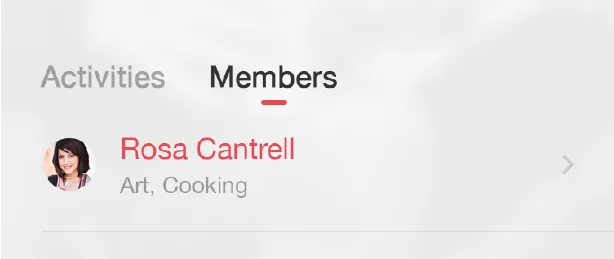如何自定义选项卡指示器的宽度?
12
- Chetan Shelake
2
在您的drawable文件夹中添加指示器图像。 - Qandil Tariq
请查看我的最新解决方案:https://dev59.com/YlcO5IYBdhLWcg3wgRsG#58381087 - Chenxi
4个回答
12
有一个更简单的方法来实现这个,只需提供一个自定义指示器的 drawable 给 app:tabIndicator。
例如,在这种情况下:
underline.xml
<?xml version="1.0" encoding="utf-8"?>
<layer-list xmlns:android="http://schemas.android.com/apk/res/android"
android:shape="rectangle">
<item android:gravity="center">
<shape>
<size
android:width="22dp"
android:height="2dp" />
<corners android:radius="2dp" />
<solid android:color="#FF0000" />
</shape>
</item>
</layer-list>
将其添加到您的TabLayout中的方法如下:
<com.google.android.material.tabs.TabLayout
android:id="@+id/tabLayout"
android:layout_width="match_parent"
android:layout_height="wrap_content"
android:layout_marginStart="@dimen/_16dp"
android:layout_marginTop="@dimen/_16dp"
app:tabIndicator="@drawable/underline"
app:tabIndicatorColor="@color/offers_header_text"
app:tabIndicatorHeight="4dp"
app:tabMode="scrollable"
app:tabRippleColor="@null" />
- Vishist Varugeese
8
试试这个:
public void wrapTabIndicatorToTitle(TabLayout tabLayout, int externalMargin, int internalMargin) {
View tabStrip = tabLayout.getChildAt(0);
if (tabStrip instanceof ViewGroup) {
ViewGroup tabStripGroup = (ViewGroup) tabStrip;
int childCount = ((ViewGroup) tabStrip).getChildCount();
for (int i = 0; i < childCount; i++) {
View tabView = tabStripGroup.getChildAt(i);
//set minimum width to 0 for instead for small texts, indicator is not wrapped as expected
tabView.setMinimumWidth(0);
// set padding to 0 for wrapping indicator as title
tabView.setPadding(0, tabView.getPaddingTop(), 0, tabView.getPaddingBottom());
// setting custom margin between tabs
if (tabView.getLayoutParams() instanceof ViewGroup.MarginLayoutParams) {
ViewGroup.MarginLayoutParams layoutParams = (ViewGroup.MarginLayoutParams) tabView.getLayoutParams();
if (i == 0) {
// left
settingMargin(layoutParams, externalMargin, internalMargin);
} else if (i == childCount - 1) {
// right
settingMargin(layoutParams, internalMargin, externalMargin);
} else {
// internal
settingMargin(layoutParams, internalMargin, internalMargin);
}
}
}
tabLayout.requestLayout();
}
}
private void settingMargin(ViewGroup.MarginLayoutParams layoutParams, int start, int end) {
if (Build.VERSION.SDK_INT >= Build.VERSION_CODES.JELLY_BEAN_MR1) {
layoutParams.setMarginStart(start);
layoutParams.setMarginEnd(end);
} else {
layoutParams.leftMargin = start;
layoutParams.rightMargin = end;
}
}
在Java文件中设置视图页面后,添加:
wrapTabIndicatorToTitle(tabLayout,80,80);
- Vidhi Dave
2
是的,使用这个解决方案我可以得到选项卡标题宽度指示器,但我想要左右两侧的填充,并且指示器应该像图片中一样居中。 - Chetan Shelake
你可以尝试将该值增加到100或者使用自定义选项卡。TextView和View,你需要这个解决方案吗? - Vidhi Dave
3
一个简单的解决方案是:
tabLayout.setTabIndicatorFullWidth(false);
但它可以与最新的依赖项一起使用,例如
implementation 'com.google.android.material:material:1.0.0'
- sudhakara k s
1
1这将使我的测试中指示器宽度与文本宽度相同。 - ssynhtn
1
对于支持库版本28.0.0,我想到了一种解决方案,替换
这里是自定义的
现在调用这个。
TabLayout.tabViewContentBounds对象为自定义对象,这样你就可以在此处应用你的逻辑,以任何你想要的方式修改指示器位置。这里是自定义的
RectF类(谢天谢地它不是final类)。public class TabIndicatorRectF extends RectF implements Serializable {
private RectF temp = new RectF();
private IndicatorBoundsModifier indicatorBoundsModifier;
public TabIndicatorRectF(IndicatorBoundsModifier indicatorBoundsModifier) {
this.indicatorBoundsModifier = indicatorBoundsModifier;
}
private interface IndicatorBoundsModifier {
void modify(RectF bounds);
}
@Override
public void set(float left, float top, float right, float bottom) {
temp.set(left, top, right, bottom);
indicatorBoundsModifier.modify(temp);
super.set(temp);
}
public void replaceBoundsRectF(TabLayout tabLayout) {
try {
Field field = TabLayout.class.getDeclaredField("tabViewContentBounds");
field.setAccessible(true);
field.set(tabLayout, this);
} catch (NoSuchFieldException | IllegalAccessException e) {
e.printStackTrace();
}
}
public static class FixedWidthModifier implements IndicatorBoundsModifier {
private float halfWidth;
public FixedWidthModifier(float width) {
this.halfWidth = Math.abs(width) / 2;
}
@Override
public void modify(RectF bounds) {
float centerX = bounds.centerX();
bounds.left = centerX - halfWidth;
bounds.right = centerX + halfWidth;
}
}
}
现在调用这个。
new TabIndicatorRectF(
new TabIndicatorRectF.FixedWidthModifier(
getResources().getDimension(R.dimen.tab_indicator_width)))
.replaceBoundsRectF(tabLayout);
- ssynhtn
网页内容由stack overflow 提供, 点击上面的可以查看英文原文,
原文链接
原文链接
